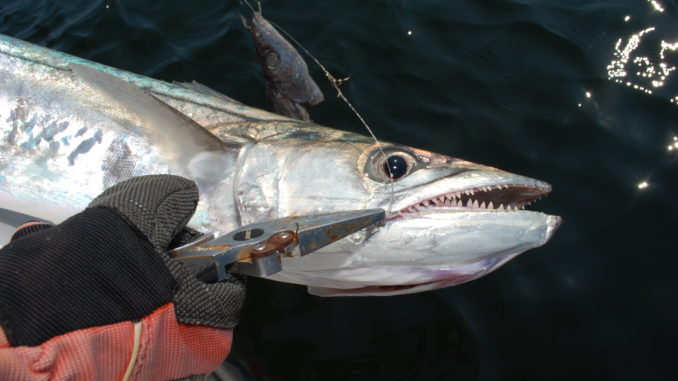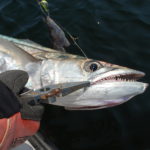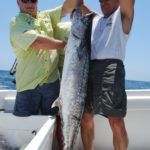
Ugly name for a fierce fish
Scientists, I am convinced, have a droll sense of humor. It is most evident in the scientific names that they conjure up to hang on some poor creature. Take, for example, the king mackerel, Scomberomorus cavalla. The “scomber” part isn’t too bad, meaning mackerel in Latin. But “morus” is derived from the Greek word “moros,” which means silly or stupid. And “cavalla,” well that stems from the Latin word “caballa,” meaning horse.
So for all eternity — or at least until another scientist can establish that another name holds precedence, this beast shall be known as “the mackerel stupid horse.”
The king mackerel is part of a decent-sized family that includes not just other sleek mackerels, but chunky tunas as well. Scombrids (their family) are high up the fish evolutionary ladder, and many of the larger family members actually exhibit warm-bloodedness, the ability to maintain body temperatures higher than the water they live in.
The king mackerel, or kingfish as it is commonly known, is the largest of the mackerels. They have been reported to 99 pounds, although the IGFA world record is an even 93 pounds for a fish taken in Puerto Rico in 1999. Louisiana’s record fish, an 82-pounder, was caught in 1980. Interestingly, seven of the top 10 kingfish in the Louisiana record books were caught in the three-year span of 1979-1981.
In 1982, the Gulf of Mexico Fishery Management Council put in place the Fishery Management Plan for Coastal Migratory Pelagic Resources to manage the fish. Since then, under improved management, not another big fish has been entered in the books. King mackerel stocks are now officially considered to be not overfished.
King mackerel are a coastal pelagic species, meaning that they live in open waters near the coast. They are common from North Carolina southward through the Gulf of Mexico to Brazil. They will occasionally be found as far north as Massachusetts.
Two separate stocks of kingfish are recognized in the U.S. Fish north of Cape Canaveral, Fla., do not migrate into the Gulf of Mexico. Within the Gulf, king mackerel are divided into two migratory sub-groups, the eastern (off the Florida Coast) and the western (Alabama to Texas).
Eastern sub-group fish winter off of southern Florida and migrate into the northern Gulf in the summer. Some range as far as Texas and even Mexico. Western sub-group king mackerel move between the northern Gulf States and Mexico, spending their winter months in the south and summer in the north.
A resident, non-migratory population of large king mackerel, very heavily made up of females, stays year round off the Louisiana coast. Waters off of Louisiana, therefore, serve as a mixing zone for the eastern sub-group, western sub-group and large resident king mackerel.
A quick glance at their razor-sharp teeth gives away what they do best, which is voraciously eat other fish. A comprehensive food-habits study was published by federal fisheries scientists in 1983. They examined 11,766 stomachs from fish taken from seven areas: North Carolina-South Carolina, Georgia, east central Florida, south Florida, northwest (panhandle) Florida, Louisiana and Texas.
Fish were clearly the most important food item for kingfish. By volume of food eaten, the percent that was fish ranged from a low of 84.9 percent in northwest Florida to a high of 99.6 percent in Louisiana.
The breakdown on food items for Louisiana king mackerel, measured by the percentage of stomachs the food was found in, can be seen in the accompanying chart.
The one family of fish that was eaten by king mackerel in all seven areas was herrings. They were also the most commonly eaten family of fish in each area. Interestingly, a small percentage of bird bones was found in king mackerel stomachs from Louisiana, south Florida and Texas.
Most species of food fishes taken from king mackerel stomachs were less than 8 inches long, generally averaging 4 to 6 inches. Surprisingly, the average length of fish eaten did not change with the size of the mackerel. In other words, bigger kingfish did not eat bigger fish.
In spite of the existence of a commercial fishery for king mackerel, primarily for ethnic markets, the species is not a highly valued food fish in Louisiana. Its greenish-gray flesh is oily and has a high fat content. To my surprise, however, I found that it makes very good sashimi.
King mackerel flesh has consistently tested high for the presence of methylmercury. The U.S. Food and Drug Administration and the Environmental Protection Agency advise women who may become pregnant, pregnant women, nursing mothers and young children to avoid consumption of king mackerel. No consumption advisory exists for expendable members of the population — older women and all adult men in general.




